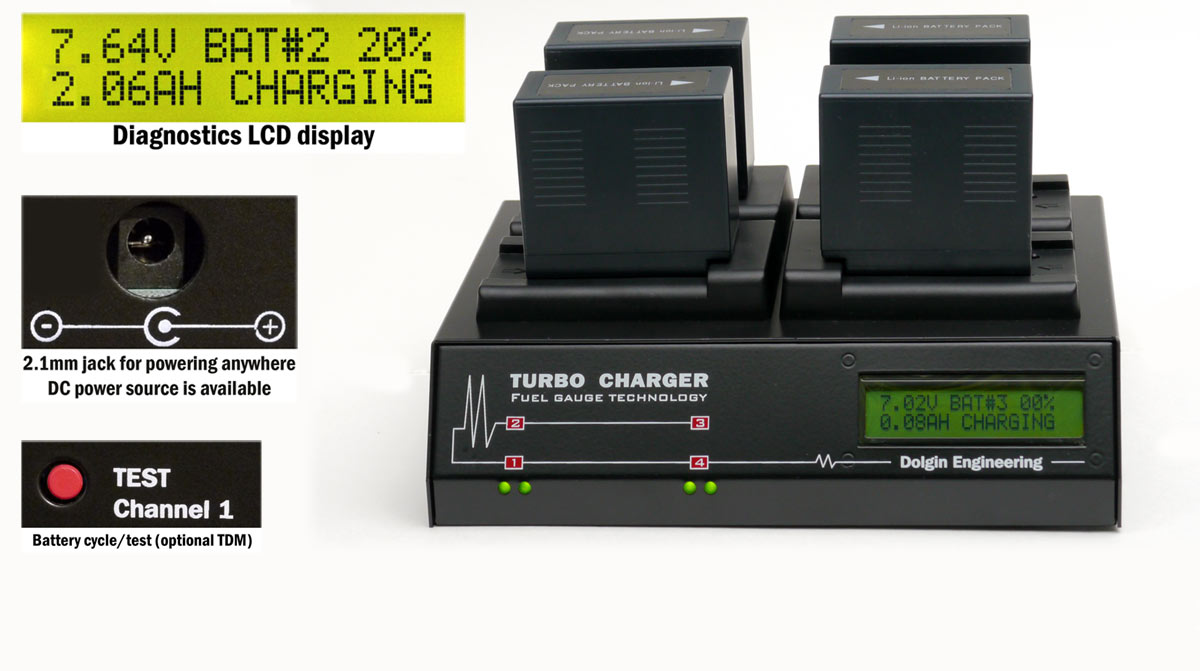FAQ
Useful linksUser ManualsCamera model/battery charger cross referenceQ. How do I adapt a charger to a new battery? Q. Can I just replace the plates myself to charge a new battery? Q. Are all batteries charged at the same time? Q. Is it safe to leave a battery on a charger? A. The charger terminates the charging process once the battery is fully charged. After that, the battery can remain on the charger indefinitely. Q. I placed a battery on a charger, the charger doesn't acknowledge it? What's wrong? 1. If a battery is fully charged, the charger will attempt to charge it for up to 1 minute, after that time the charger will report "Channel #XX Ready"(TC400) and illuminate the Green LED. Q. Can I charge multiple types of batteries at the same time - for example, some are Panasonic HVX200 and some are Sony PD170? A. Yes, make sure to order a custom configuration version of the charger so that it will come equipped with the correct matching plates. Q. Can I use Solar Power to charge batteries? A. Yes, while selecting a panel, make sure it is rated at ~ 60W or more (BatteryStuff.com or Sundance Solar) for the TC400 family. The TC40 requires at least ~40W, and the TC200 requires at least 25W. Please note that since panel voltage is not regulated there is a possibility of damage to the charger. Q. Can I charge Sony BP-U style batteries (BP-U60 or similar) using 12V car power? A. Yes, all our chargers for BP-U60 batteries require 18V-20V DC power. It is supplied by the 19V AC adapter that comes with a charger. For a 12V DC power source (car power) we suggest ordering an optional 12V/19V step-up voltage power adapter when ordering a charger. This DC adapter should be used when charging batteries in a car. Q. Is it safe to use the Dolgin Engineering chargers with the newer Canon LP-E6NH batteries? Yes https://camnostic.com/2021/01/canons-lp-e6nh-battery-performance-meh/ Phase One battery charger Phase One offers a Canon compatible battery for powering their Digital Backs, and labels them as BP-911/914/915. They are rated as 3400 mAh by Phase One, while when Canon produced BP-911/914/915 they were rated at 2,000 mAh only. Given the fact that the Phase One batteries are in fact rated as 3400 mAh by the company, we consider charging them on our chargers appropriate and safe. While ordering, use -CAN suffix to specify Canon configuration. (i.e. TC400-CAN, TC200-i-CAN). |
||||||||
|
Batteries Charging Li-Ion batteries to full capacity Q. How do I relate amp-hour rating, say 6,000 mAh, to battery A. Multiply the Ah number by the battery voltage (7.2V nominal for the Panasonic DVX100 camera). Q. How much run time can I expect to get from a battery? A. Run time is calculated by dividing the Wh rating of a battery by a camera's power consumption. In the case of a DVX100, its power consumption is about 8W. Dividing 43.2 Wh by 8W results in about 5.5h calculated run time. Manufacturing variations and aging may result in slightly different actual results. Your mileage may vary. Q. Do I need to discharge my Li-Ion battery before charging? A. Li-Ion chemistry does not benefit from discharging. Doing so does not make it last longer, and deep discharge will shorten Li-Ion battery life cycle. Interpreting "C": While discharging at 1C it takes a battery 1 hour to fully discharge; discharging at 1/2C takes 2 hours; discharging at 2C takes 1/2 hour. Q. My camera requires 7.2V DC power, but the battery I want to use is 7.4V. Will it work? Is it OK to use a 7.4V Li-ion battery to replace a 7.2V battery? A. All Li-Ion DV batteries measure up to 8.4V for the fully charged, down to about 6V discharged. This is true for any brand, make, model. It has something to do with how the Li-Ion chemistry works. All modern smaller-size cameras are designed to operate in this range (6V-8.4V). This is true no matter what the label says (7V, or 7.2V, or 7.4V). In other words, labeling for the camera voltage is just that - labeling. Actual voltage depends on the battery state of charge.This is also true for the larger cameras like Sony EX1/EX3, and any other models using Anton Bauer or V style batteries. The batteries are usually called 14.4V, the camera power specification often calls for either 12V or 14.4V. In any case, all larger Li-Ion batteries operate in the 12V-16.4V range (a freshly charged battery is 16.4V, discharging down to ~12V). Q. Do Li-Ion batteries have "memory"? A. Li-Ion chemistry is inherently memory free Q. What is "battery memory" A. This effect was first discovered in the early days of Ni-Cad chemistry. Since that time the "memory effect" has sometimes been misunderstood and exaggerated. Please refer to this article Q. My battery has started to expand, specifically, the plastic case is expanding on the top and the bottom, can I still use it? A. We recommend discontinuing the use of this battery as these are signs of imminent failure. Q. My battery does not last more than a few minutes. Can this be fixed? A. Li-Ion batteries can not be rejuvenated by charging/discharging them, or using any other "tricks." Expect 2-3 years of service before run time deteriorates. Q. Are new Canon LP-E6NH batteries compatible with Dolgin Engineering battery chargers? A. Yes. Here is the test report published by Camnostic. The model used for testing is TC400-DSLR-C-TDM Q. Redvolt BP batteries do not charge A. Redvolt BP batteries self discharge while in storage and go into the hibernation Q. Need help in understanding the TC40/TC200 LED blinking pattern |
||||||||



